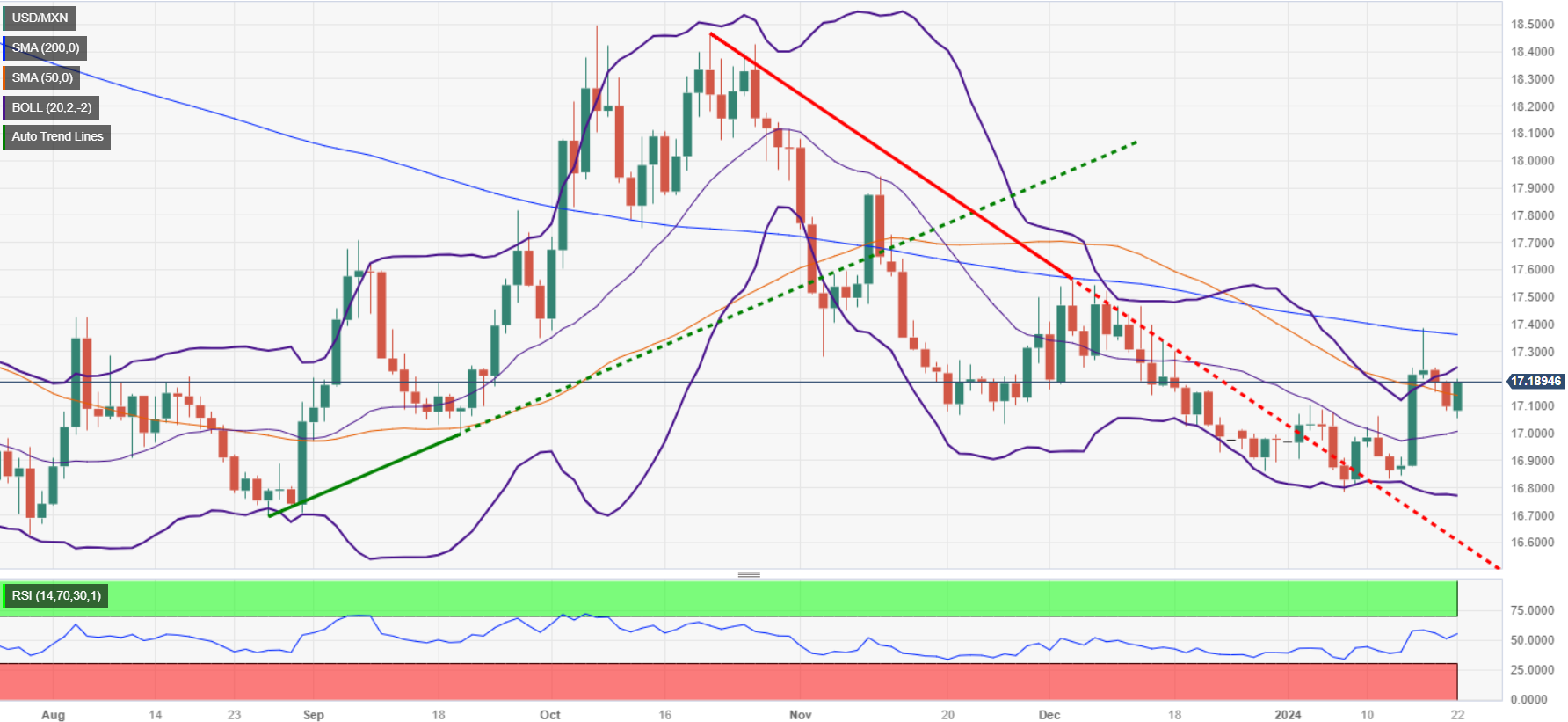- The Mexican Peso starts the session lower while the Dollar Index (DXY) remains stable around 103.24.
- Despite Wall Street's gains, USD/MXN fails to rebound strongly due to improving risk appetite and falling US Treasury yields.
- In Mexico, economic activity and inflation will be published.
The Mexican Peso begins Monday's session lower against the US Dollar (USD), as the Dollar limited its previous losses, as shown by the US Dollar Index (DXY), which remains virtually unchanged near 103.24 . Alongside this, an improvement in risk appetite and falling US Treasury yields have prevented the USD/MXN from gaining ground to higher levels, with the pair trading at 17.18, rising 0.65%.
Wall Street posts solid gains, which would normally strengthen the Mexican currency. However, the lack of economic data on the agenda for Mexico on Monday and Tuesday leaves traders leaning toward data from the United States. The Mexican agenda will gain momentum on Wednesday with the publication of the economic activity report, along with mid-January inflation data.
Meanwhile, Federal Reserve (Fed) officials are absent as they enter their blackout period ahead of the January 30-31 monetary policy meeting.
Daily market summary: The Mexican peso, on the defensive and with special attention to new data
- Meanwhile, former deputy governor of the Bank of Mexico (Banxico), Everardo Elizondo, commented that it is too early to relax monetary policy in Mexico, adding: “There are enough reasons to remain concerned.” Elizondo argued: “If it loosens [la política]inflationary expectations will deteriorate.”
- The latest economic data from Mexico points to a slowdown in the economy, as retail sales missed forecasts and fell below October data. At the same time, the economy is expected to grow 2.6%, below forecasts of 3%.
- On the US front, last week's economic data paints a picture of a soft landing. Although housing data was mixed, improving US household sentiment and lower inflation expectations supported the USD/MXN.
- Atlanta's GDPNow model suggests last year's fourth quarter would likely grow 2.4%, driven by strong retail sales, firm industrial production, a tight labor market and improving consumer sentiment.
- Traders cut their bets on a dovish Federal Reserve in 2024. They are at 142 basis points (bps) of cuts, down from 175 bps last week.
- The biggest catalyst last week was Federal Reserve Governor Christopher Waller's speech: “There is no reason to move as fast or cut as quickly as in the past.” This kept investors at bay, even though Waller supported rate cuts if inflation really fell.
- Mexico witnessed a spike in headline inflation, but underlying data suggests that the Bank of Mexico (Banxico) has done a good job, curbing the rise in prices after raising rates to 11.25%.
- Although the minutes of the December meeting of Banxico (the Central Bank of Mexico) indicate that it may consider easing its monetary policy, the December inflation report represents a possible obstacle to such easing.
- Standard Chartered analysts estimate that the Bank of Mexico (Banxico) will lower rates to 9.25% in 2024.
- On January 5, a Reuters poll suggested that the Mexican peso could weaken 5.4% to 18.00 per dollar in the 12 months to December.
Technical Analysis: The Mexican peso remains weak, while the USD/MXN moves around the 50-day SMA.
The daily chart of USD/MXN shows that the pair is strengthening, testing the 50-day SMA at 17.15, ahead of a key resistance level at the 200-day SMA at 17.36. Once above these levels, the pair will continue to rise, followed by the 100-day SMA at 17.42 and 17.50. If this last level is exceeded, the pair will be exposed to a fall. Breaking this last level would expose the May 23 high at 17.99.
On the other hand, if sellers limit the recovery of the 50-day SMA, the pair could suffer further losses. First support would be the January 22 low at 17.05, 17.00, and the January 12 cycle low seen at 16.82.
USD/MXN Price Action – Daily Chart

Frequently Asked Questions about the Mexican Peso
What is MXN?
The Mexican Peso is the legal tender of Mexico. The MXN is the most traded currency in Latin America and the third most traded on the American continent. The Mexican Peso is the first currency in the world to use the $ sign, prior to the later use of the Dollar. The Mexican Peso or MXN is divided into 100 cents.
What is Banxico and how does it influence the MXN?
Banxico is the Bank of Mexico, the country's central bank. Created in 1925, it provides the national currency, the MXN, and its priority objective is to preserve its value over time. In addition, the Bank of Mexico manages the country's international reserves, acts as a lender of last resort to the banks and advises the government economically and financially. Banxico uses the tools and techniques of monetary policy to meet its objective.
How does inflation impact the MXN?
When inflation is high, the value of the Mexican Peso (MXN) tends to decrease. This implies an increase in the cost of living for Mexicans that affects their ability to invest and save. At a general level, inflation affects the Mexican economy because Mexico imports a significant amount of final consumption products, such as gas, fuel, food, clothing, etc., and a large amount of production inputs. On the other hand, the higher the inflation and debt, the less attractive the country is for investors.
How does the Dollar influence the Mexican Peso (MXN)?
The exchange rate between the USD and the MXN affects imports and exports between the United States and Mexico, and may affect demand and trade flows. The price of the Dollar against the Mexican Peso is affected by factors such as monetary policy, interest rates, the consumer price index, economic growth and some geopolitical decisions.
How does the Fed's monetary policy affect Mexico?
The exchange rate between the USD and the MXN affects imports and exports between the United States and Mexico, and may affect demand and trade flows. The price of the Dollar against the Mexican Peso is affected by factors such as monetary policy, interest rates, the consumer price index, economic growth and some geopolitical decisions.
Source: Fx Street
I am Joshua Winder, a senior-level journalist and editor at World Stock Market. I specialize in covering news related to the stock market and economic trends. With more than 8 years of experience in this field, I have become an expert in financial reporting.







